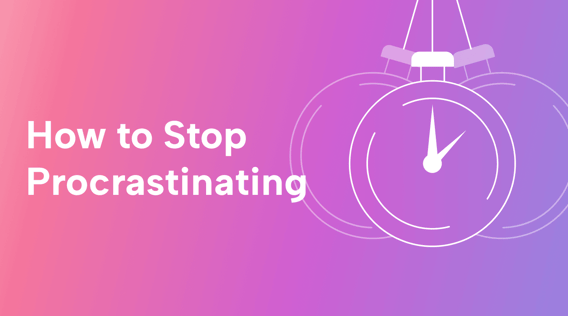Procrastination can be a significant barrier to achieving our goals. It leaves us feeling stressed, overwhelmed, and unproductive, which makes us feel even less inclined to do our work.
Fortunately, it’s a habit you can break.
With the right strategies in place, you can overcome procrastination in your daily work. It’s not always easy, but it’s possible.
In this article, we’ll explore various methods that can help you stop procrastinating and start taking action toward your goals. We'll discuss the root causes of procrastination, how to set achievable goals, and how to use time management techniques to maximize productivity.
Before we dive in, let’s take a deeper look at what procrastination is and why we do it in the first place.
What is procrastination?
If you’re reading this article, chances are you already know what procrastination is. In fact, you’re probably here looking for a way to stop it from happening. But just so we’re all on the same page, let’s define what procrastination actually is.
Procrastination involves delaying or postponing a task or action that needs to be done. It’s a common behavior that affects people of all ages in different situations. From not wanting to write to avoiding cleaning the bathroom, procrastination manifests for a variety of reasons.
Chronic procrastination can have damaging consequences on productivity, well-being, and mental health. It can increase negative emotions (such as stress and anxiety) by causing us to miss deadlines, lower productivity, and decrease performance.
The exact process varies from person to person. However, the general phases of procrastination are outlined in the procrastination circle.
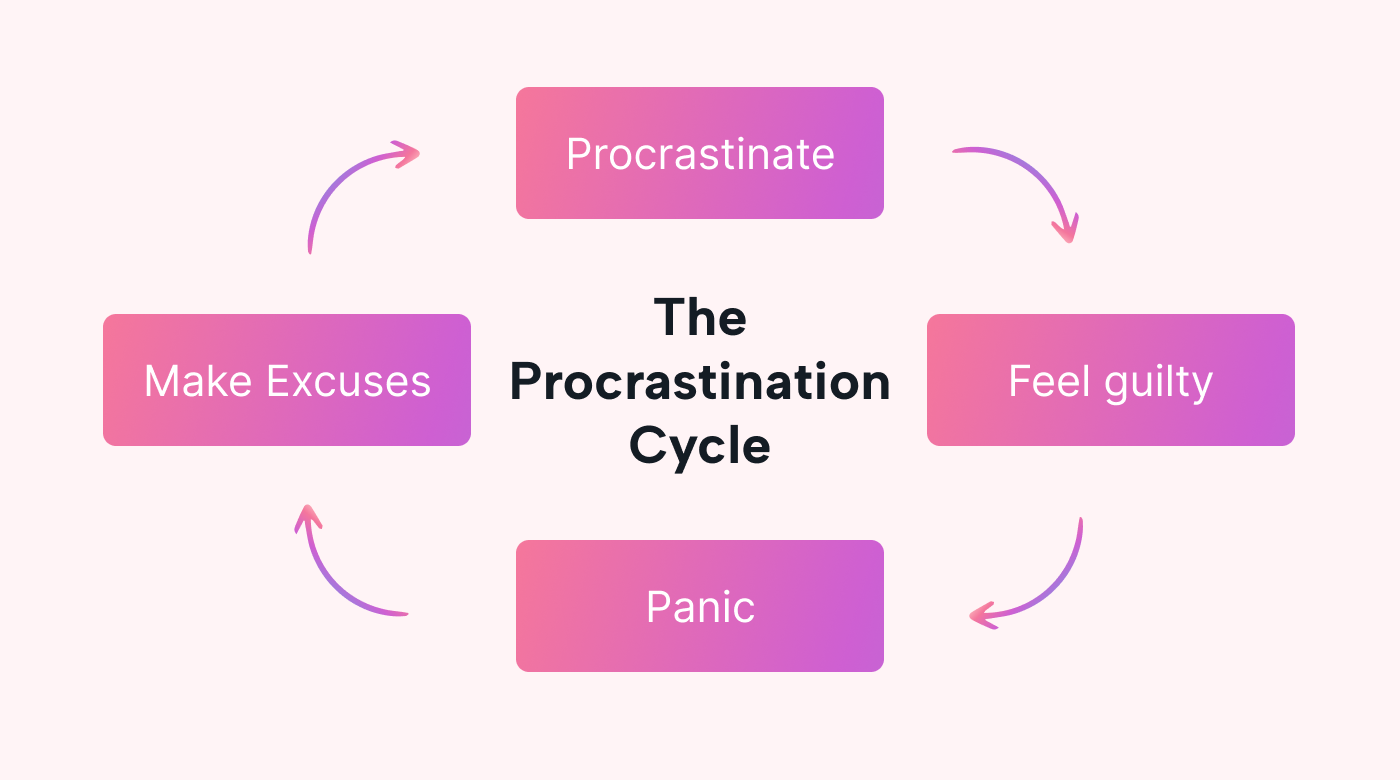 |
Let’s look at these steps in more detail.
- Procrastinate. The first step is procrastination, which means you’re putting off whatever it is you need to do. In this example, let’s say you need to prepare a sales presentation for a new client. You know it will take a lot of effort to review and analyze all the data, so you put it off.
- Feel guilty. Because you’re not doing what you’re supposed to be doing, you start to feel guilty. The more you procrastinate, the guiltier you feel.
- Panic. As time goes on, panic sets in because you’re worried about not doing what you’re supposed to be doing. The client meeting is approaching, and you’re still not working on the presentation.
- Make excuses. Before you know it, you'll justify your procrastination to relieve some of the pressure. You're under a lot of pressure, so it's not surprising that you don't want to finish the presentation, right? Give yourself a break! Or perhaps you can work late one evening next week to complete the presentation, so does it matter that you haven't done it today? Nope, it's all good! By making excuses, you're more likely to continue procrastinating — and so the circle continues.
What is the main cause of procrastination?
It’s hard to assign a ‘main cause’ to procrastination because there are many contributing factors. Plus, everyone has different reasons for not wanting to do their work.
Here are some of the leading reasons for procrastination:
- Perfectionism: Some people procrastinate because they have high standards for themselves and fear they won't meet them. They delay starting the task until they feel more prepared.
- Lack of motivation: When faced with a boring task that isn’t interesting or rewarding, it can be challenging to find the motivation to start or complete it. There are other things that interest you more, so you procrastinate and do those instead.
- Fear of failure: Some people avoid starting difficult tasks because they worry they’ll fail. They want to avoid the discomfort of failure, so they do something else (like a task they know they can complete).
- Feeling overwhelmed: When a task or project is too big or complex, it can feel overwhelming. People may procrastinate because they don't know where to start.
- Poor time management: Poor time management skills (such as not setting priorities or failing to correctly estimate how long a task will take) can lead to procrastination. Like the previous point, you have too much on your plate, which overwhelms you. It can feel easier to ignore the problem and focus on something else when this happens.
- Distractions: In today's digital age, distractions are everywhere. For example, online tools such as social media and streaming platforms can all be a source of procrastination — especially for employees working at home.
10 tips and techniques to break procrastination
If you’re looking for a magic recipe to stop procrastination, we have some bad news. It doesn’t exist.
However, there are some best practices you can follow to reduce the likelihood of procrastination. We’ve outlined 10 of them here, so keep reading to find out more about how to prevent procrastination.
1. Plan and organize your work
Planning your work is a great place to start when trying to mitigate procrastination. It clarifies your work schedule, making it clear what you need to do and when you need to do it. As a result, you’re less likely to feel overwhelmed by how much work you have.
So how exactly can you plan and organize your work?
Here are a few tips to guide you in the right direction.
- List all your tasks. Start by outlining all the tasks you need to complete.
- Identify your deadlines. Outline the deadlines for all the tasks in your workflow. This will help you organize which tasks to complete by certain dates.
- Assign a timeframe to each task. To plan your work schedule, you need to know how long tasks will take. Based on your previous experience, estimate how long each task should take. Be sure to overestimate if you’re not sure.
- Prioritize your tasks. To help you plan which tasks to focus on first, you should also prioritize tasks (we’ll talk about how to prioritize tasks in tip #3).
To manage this process, you can also use a work management tool.
Work management software lets you plan, track, and manage your workload. Take Motion as an example. Our intuitive platform allows you to build, design, and automatically update your work schedule.
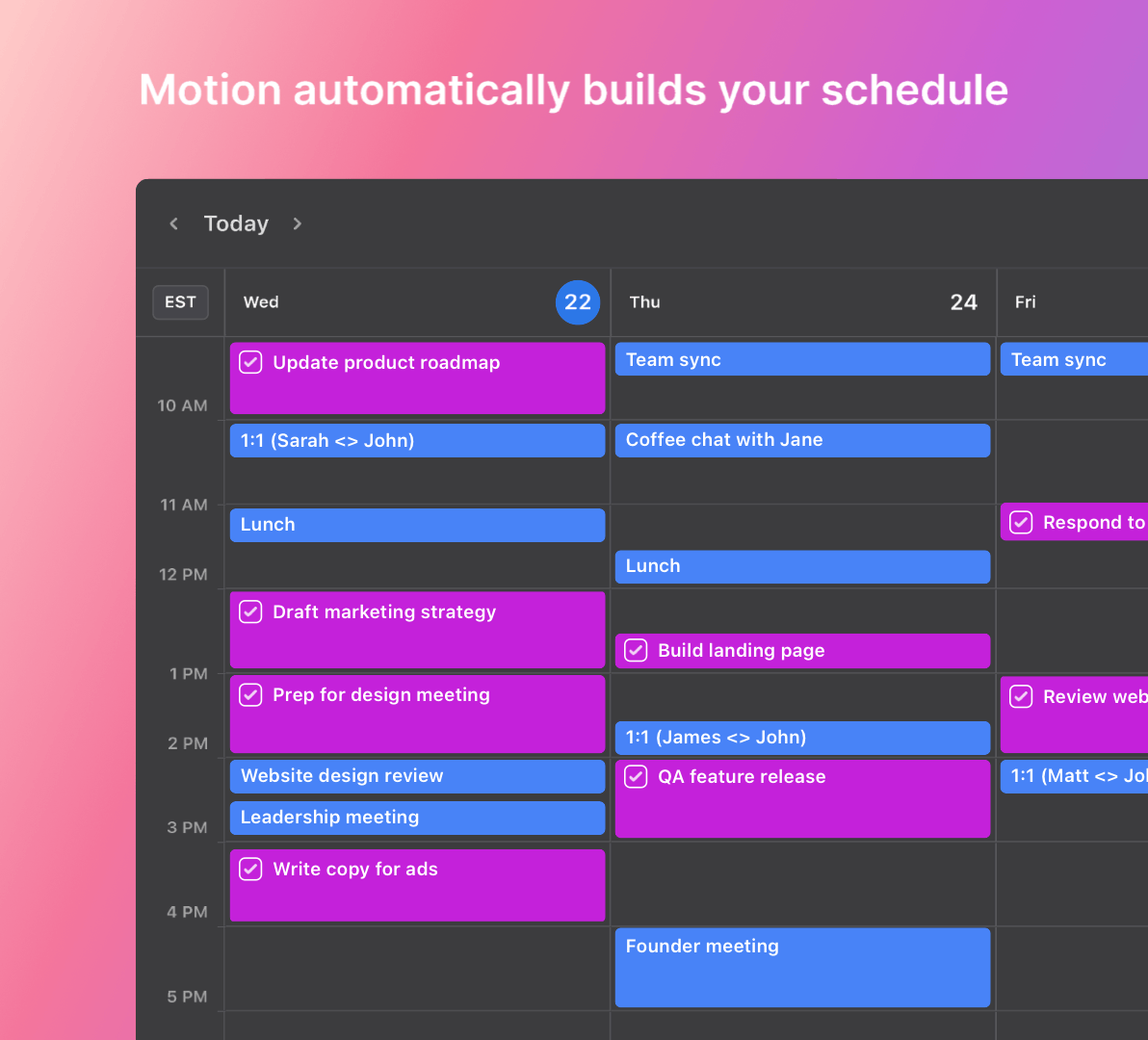 |
Learn more about how our Intuitive Calendar works.
2. Set clear goals
A clear vision of your plans can help you stay motivated and focused. This is where setting goals and objectives comes in handy. By establishing reasonable goals, you’ll give yourself something to work towards.
When it comes to setting goals for your work schedule, make sure you choose a timeframe. Will you have daily goals or a long-term goal for the month? There's no right or wrong answer here. It's totally up to your personal preference.
Your goals should also be clear and specific so you know what you’re working towards. For example, ‘complete tasks [x,y, and z] by the end of the week.’ That way, you know exactly which tasks you must complete and when.
3. Prioritize your tasks
Prioritization is a great way to determine which tasks to work on if you have a busy schedule. It’ll help you focus on completing the most critical tasks first, alleviating some pressure from your workload.
There are different ways to identify top-priority tasks. The Eisenhower matrix is a popular example.
The matrix helps you prioritize tasks based on urgency and importance. It splits your tasks into four quadrants:
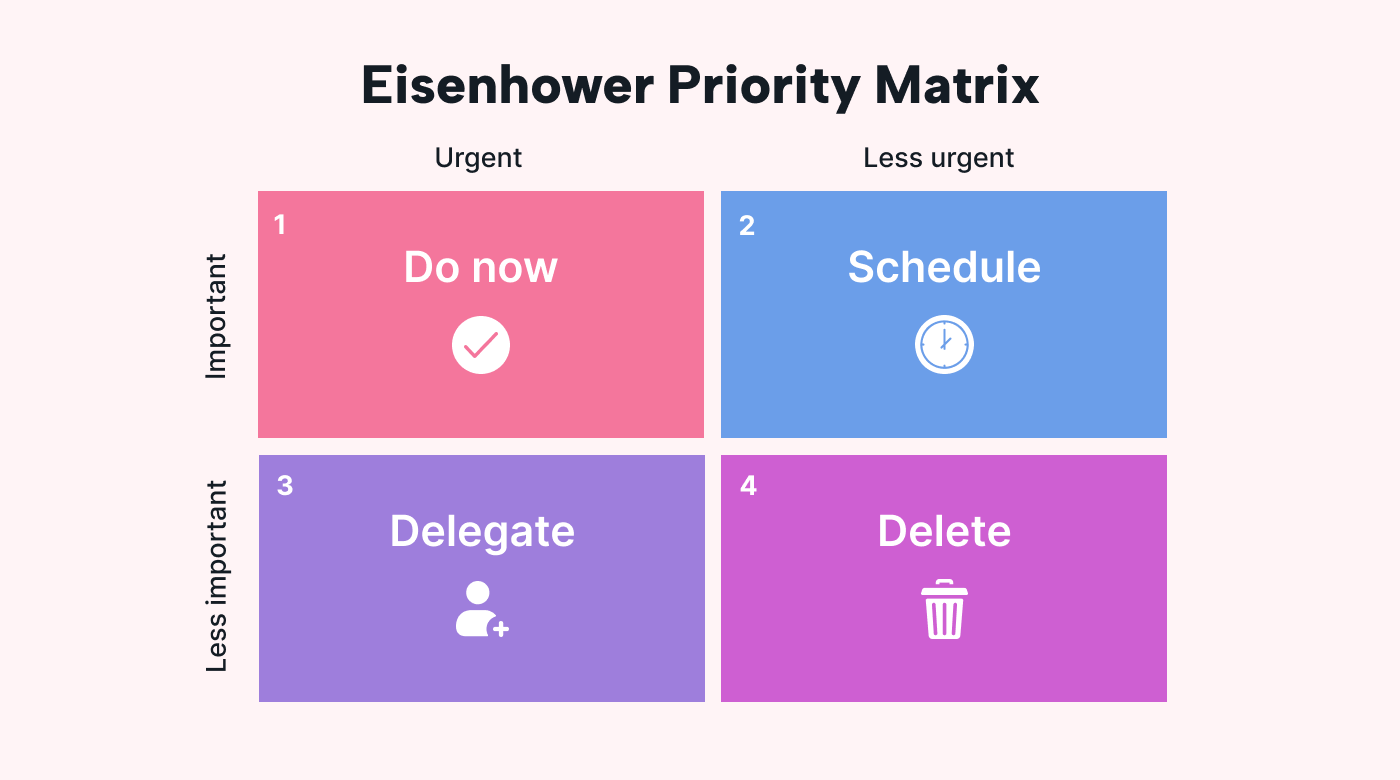 |
You can effectively plan your workload to prioritize the essential tasks from here. You assign tasks in the quadrants based on their urgency and importance. As a result, you know you’re focusing on the right tasks first, which makes your workload feel less overwhelming.
Using a work management tool like Motion can also help you prioritize tasks. With our platform, you can label and categorize tasks based on their priority level. That way, you can instantly see which tasks are more important.
 |
Our workspace also automatically updates your schedule to prioritize important tasks. So if your schedule changes, we’ll update your calendar with the top-priority tasks first. This means you can spend less time organizing your schedule and more time getting things done.
4. Break tasks into smaller steps
To prevent yourself from procrastinating when facing complex tasks, try breaking them into smaller, more manageable steps. That way, you’ll have a clear picture of all the steps you need to take to complete the task, which makes it feel less daunting and more achievable.
Here’s how you might break down a large task into smaller components:
- Look at the task as a whole. Step back and take a look at the entire task. Ask yourself what you’re trying to achieve and what the end goal should be. This will help you stay focused on what needs to be done and what the subtasks should be.
- Identify the key areas of work. Look for the critical areas of work within the task. For example, if the task is to launch a social media campaign, the core work areas could be creating visuals, writing copy, and scheduling posts.
- Split the task into smaller steps. Now that you know the key areas, you can start splitting the tasks into smaller steps. For example, if creating visuals is a key task area, you can break it down into designing different types of visuals or gathering quotes to turn into images.
5. Use the two-minute rule
The two-minute rule is a productivity strategy often associated with David Allen's "Getting Things Done." Allen says that if a task takes two minutes or less to complete, you should do it immediately instead of postponing it. By quickly addressing small tasks as they arise, you can prevent them from piling up and becoming overwhelming.
For example, let’s say you’re working on a big project with multiple deadlines. It’s a lot to manage, and you’re pretty busy. On Monday morning, you start work and notice a few emails in your inbox. You have a lot on your schedule today, but responding to these emails will only take a few minutes. So, you click reply and shoot off some emails.
It took five minutes out of your day, but now it’s done, and you can focus on the larger tasks without thinking about replying to emails.
If you choose not to reply to those emails, you’ll probably have more the next day. By the end of the week, replying to those emails is a bigger task, making you more likely to put it off by procrastinating.
By prioritizing and accomplishing these small tasks quickly and efficiently, you also get a greater sense of accomplishment and motivation to tackle more significant tasks. You know you’ve ticked emails off the list, so you’re more inclined to continue your productivity throughout the day.
6. Incorporate the Pomodoro Technique
The Pomodoro Technique is a time management and productivity strategy developed by Francesco Cirillo in the late 1980s. It involves breaking work into 25-minute intervals (known as pomodoros), followed by a five-minute break.
During each pomodoro, you focus on and work on a single task without interruptions or distractions. If a distraction arises, you note it down on a piece of paper and deal with it during your next break.
You repeat the process several times and then take a more extended break. For example, after four pomodoros, you take a longer break of around 15–30 minutes.
This method is great for increasing focus and boosting productivity. You avoid any distractions and give all of your attention to a specific task for a short amount of time.
This technique can benefit anyone who needs support to focus on lengthy tasks. You know you have 25 minutes of hard work, and then you can have a break. It makes tasks easier to complete without forcing yourself to focus constantly without breaks.
7. Review the 80/20 rule
The 80/20 rule (also known as the Pareto Principle) states that 80% of the effects come from 20% of the causes. It helps businesses identify which inputs are the most productive and make them the priority.
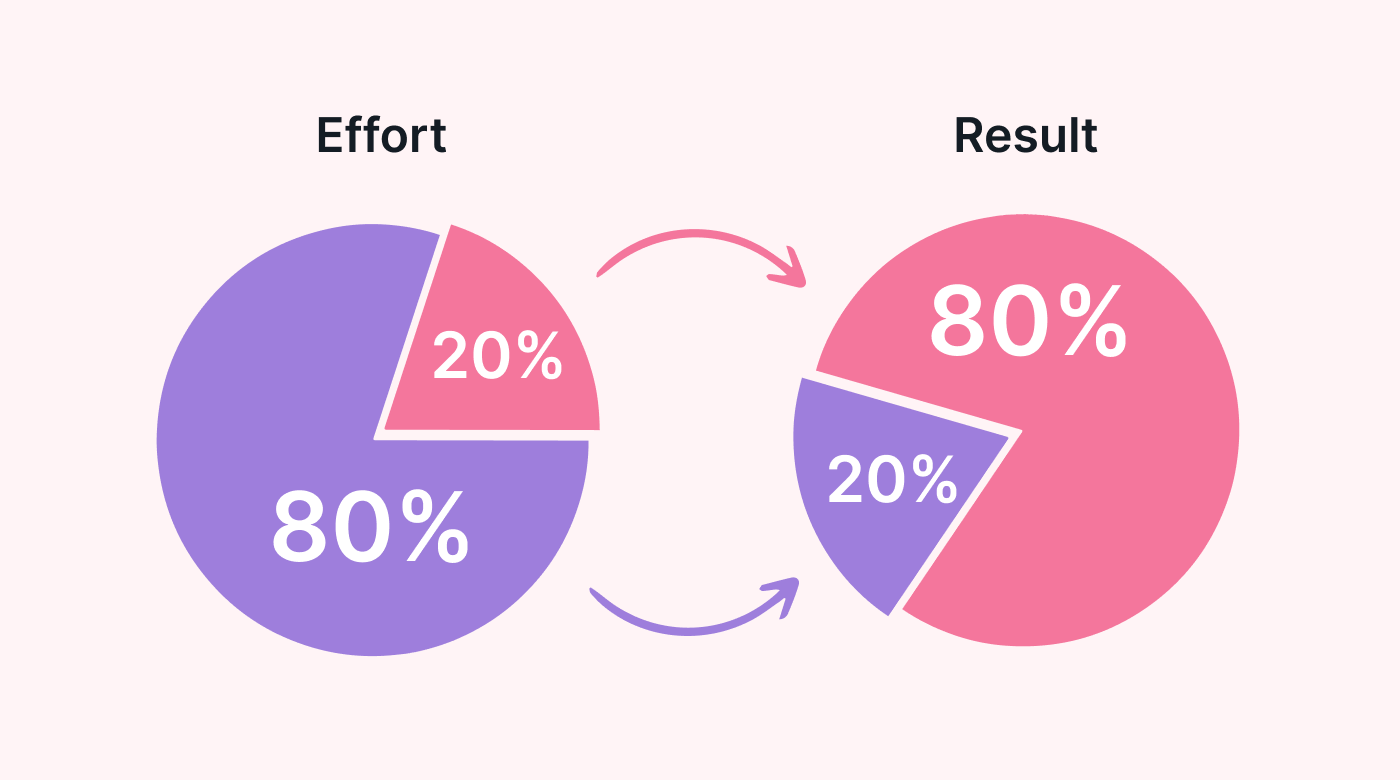 |
The concept behind the 80/20 rule can also apply to procrastination, meaning a small number of factors are responsible for most of your procrastination.
So what’s the solution?
It’s simple: identify and address the most significant reasons for your procrastination. To do this, start by identifying the top 20% of factors contributing to your procrastination.
Then, focus your efforts on overcoming those factors.
For example, let’s take the fear of failure as the main reason you procrastinate. You might work on building your confidence and resilience through positive self-talk, visualization, or seeking support from others.
By addressing the main cause of your procrastination, you can prevent it from happening or stop it altogether.
8. Remove distractions
We’ve already touched on distractions with the Pomodoro Technique. But if you decide the Pomodoro Technique isn’t right for you, there are other ways to remove distractions.
First, you need to pinpoint what your main distractions are. Is it social media? Your television while working at home? Constant conversations with coworkers?
Whatever it is, be clear about what they are. Then, you can put measures in place to remove them.
If your phone distracts you, here’s what you could try:
- Turn off notifications on your phone
- Move your phone to another room/leave it in your bag
- Turn it off
- Set timeframes when you’re allowed to check your phone
By removing the temptation of distraction, you’re more likely to fulfill deep work and boost your productivity.
9. Reward yourself
An excellent way to motivate yourself to keep working is to set up a reward system for completing tasks or making progress. This technique can help you stay motivated and build momentum toward accomplishing your goals.
Here are a couple of examples of how to reward yourself when making progress or hitting milestones
- Take a break. When you complete a milestone in your workload, reward yourself with a break. Go for a walk, grab a coffee, or talk to a coworker (so long as you’re not distracting them from their work).
- Let someone know. It’s always a nice feeling to be appreciated for our work. Let someone know if you’re proud of what you’ve accomplished and how far you’re progressing. Their appreciation or praise can be your reward. Plus, it can motivate you to keep going. It’s a win-win.
10. Set realistic habits
Creating good habits is vital to reducing procrastination. It provides structure, repetition, and clarity — all of which reduce your desire to procrastinate.
But it’s no use setting new habits if they aren’t sustainable. In fact, unrealistic habits can have the opposite effect. If you can’t stick to your new habits, you’ll start to feel overwhelmed. And what happens when we feel overwhelmed? We tend to procrastinate.
So make sure any changes you make to your routine and work style are realistic, achievable, and long-lasting. Otherwise, you’ll be back to where you started.
To do this, focus on small ways to make positive changes. If you often get distracted while checking your phone, try to overcome this challenge by creating a work habit where you only check your phone for 30 minutes daily.
This small change might not sound like a big deal, but it’s a habit that’ll help you reduce procrastination and increase your productivity.
Use Motion to manage your workload and reduce procrastination
If you’re constantly balancing too much work and trying to hit various deadlines, the desire to procrastinate is probably looming over your shoulder. By organizing your work, prioritizing your schedule, and setting goals, you’ll be in a much better position to finish your work without distraction.
Try Motion for free today to help you manage your work schedule effectively. Our platform prioritizes tasks for you, calculates your working hours, and lets you know if completing a task by the deadline is impossible.

